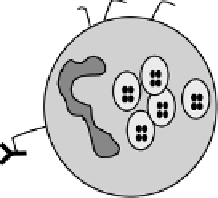Biomedical Engineering Reference
In-Depth Information
T-cell
receptor
F
c
RI receptor
Antigen/allergen
T-helper
cell
Mast cell
Y
Y
Y
IL-4
IL-13
Antigen/allergen
Antigen
presenting cell
Y
Y
Y
Y
B cell
Mediator
release
Plasma cell
IgE
IL-4, IL-5, IL-6
FIGURE 20.3
The allergic cascade. (Modified from Hamelmann E, Rolinck-Werninghaus C and Wahn U. 2002. From IgE to
Anti-IgE: Where do we stand?
Allergy
57: 983-994.)
20.1.3
Importance of Immunoglobulin E
Allergies represent a very serious health problem, with the prevalence of asthma, hay
fever, and other IgE-mediated diseases dramatically increasing over the past two to three
decades in industrialized countries (7; 11). In the United States, for example, asthma
prevalence increased by 75% between 1980 and 1994 (12), with an estimated 15 million
individuals affected and more than 5000 asthmatics dying annually (11). In Britain, 23% of
children aged 6-7 years and 21% of children aged 12-14 years suffer from asthma (13).
Furthermore, in Sweden, the number of children with allergic rhinitis, asthma, or eczema
doubled during the years 1979-1991 (14). In addition, the high degree of morbidity asso-
ciated with allergic disorders requires large quantities of costly medication to relieve
symptoms. In the United States for example, the total annual costs for treating asthma
were estimated at $6 billion in 1997 (15).
A number of theories attempting to explain the observed increase in allergic disease
have been put forward, many of them centring on the role of the western lifestyle.
Reasons put forth include the increase in air pollution as well as a lack of exposure of the
immune system to infections due to increased sanitization and vaccinations, resulting in
the failure of the immune system to “learn” optimally (10). Although there is much evi-
dence to support these hypotheses, the causes remain complex and many unknowns still
remain.












































